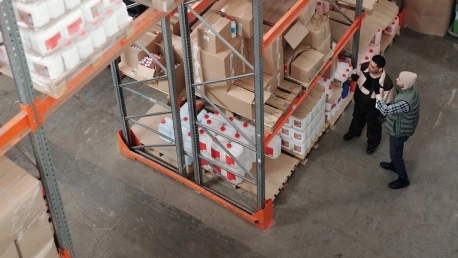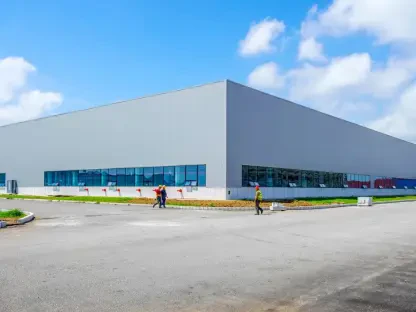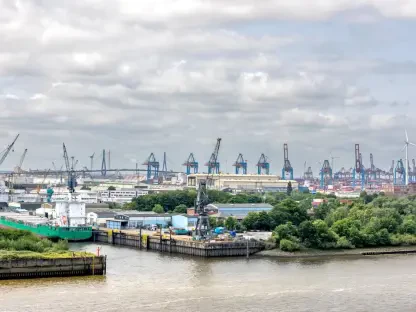The logistics and construction industries in the United Kingdom are witnessing a significant transformation with the rise of sustainable warehouses. These facilities are designed to meet the increasing market demand for environmentally responsible and efficient operational spaces. Notable recent developments, like the planned 330,000 square foot sustainable warehouse in Little Hulton, Bolton, underscore this trend. In this article, we explore the importance of sustainable warehouses and whether they represent the future of UK logistics infrastructure.
The Rising Demand for Sustainable Logistics Facilities
In recent years, there has been a noticeable shift towards sustainability in various sectors, including logistics. Companies are increasingly recognizing the importance of reducing their carbon footprint and embracing eco-friendly practices. This change is driven by a combination of regulatory pressures, market demand, and a genuine commitment to corporate social responsibility. The significance of sustainable logistics facilities is growing as businesses aim to align their operations with global sustainability goals.
Market Trends and Sustainable Goals
Industry leaders are investing heavily in green building initiatives, reflecting a broader market trend towards sustainability. This is exemplified by the actions of leading logistics real estate developers such as Logicor, Panattoni, and DP World. For instance, Logicor’s initiative to build a sustainable warehouse in Bolton demonstrates a commitment to meeting high sustainability ratings, like BREEAM Outstanding and EPC A. Such ratings are benchmarks of excellence in building design and environmental performance, and they represent the industry’s efforts to implement eco-friendly practices. The push for greener logistics solutions also aligns with regulatory requirements that mandate stricter environmental standards, further propelling the sector towards sustainability.
Industry Case Studies
Examples of this shift can be seen in projects undertaken by leading logistics real estate developers. For instance, Logicor’s initiative to build a sustainable warehouse in Bolton highlights the company’s commitment to eco-friendly practices and the growing market demand for sustainable logistics facilities. Similarly, the eco-conscious developments by Panattoni and DP World in Coventry underline the industry’s move towards greener practices. These projects aim to achieve high sustainability ratings, such as BREEAM Outstanding and EPC A, signifying the industry’s dedication to environmental responsibility. Collectively, these developments illustrate a significant trend in the logistics sector, emphasizing the importance of sustainable design and construction in meeting both regulatory standards and market expectations.
Key Features of Sustainable Warehouses
Sustainable warehouses incorporate several innovative design and construction features to minimize their environmental impact. These elements not only reflect a commitment to eco-friendly practices but also enhance the efficiency and operational effectiveness of these facilities. The following sections delve into the integral design and construction innovations, as well as the technological advancements that characterize sustainable warehouses.
Design and Construction Innovations
The design and construction of sustainable warehouses emphasize the use of recycled materials, ergonomic designs to enhance energy efficiency, and advanced building management systems to monitor and reduce energy consumption. In the case of the Bolton warehouse, initiatives like grouting existing mine shafts and ground improvement efforts are critical to ensuring long-term sustainability. By incorporating recycled materials and advanced construction techniques, these facilities exemplify the industry’s dedication to reducing their environmental footprint. Additionally, ergonomic designs help in optimizing energy use, leading to significant savings and improved operational efficiency.Other innovative construction techniques, such as the use of thermal insulation and energy-efficient windows, further reduce energy consumption. Advanced building management systems enable real-time monitoring and adjustment of energy use, ensuring optimal performance at all times. Moreover, sustainable warehouses often feature green roofs and vertical gardens, which not only enhance aesthetic appeal but also contribute to local biodiversity. The integration of these features signifies a holistic approach to sustainability, addressing energy consumption, material use, and ecological impact.
Technological Advancements
Beyond construction, technological advancements play a crucial role in the efficiency of these facilities. Features such as LED lighting, electric vehicle (EV) charging points, and rainwater harvesting systems are increasingly common. These technologies not only reduce environmental impact but also lower operational costs, creating a win-win situation for developers and tenants alike. LED lighting systems offer significant energy savings compared to traditional lighting, while EV charging points promote the use of electric vehicles, reducing greenhouse gas emissions.Rainwater harvesting systems capture and reuse rainwater, further decreasing the demand for potable water and reducing operational costs. Additionally, robotics and automation technologies are being integrated into warehouse operations to improve efficiency and reduce labor costs. These advancements allow for more precise inventory management, faster order processing, and reduced energy use. By leveraging these technologies, sustainable warehouses can achieve higher operational efficiency and environmental performance, setting a new standard in the logistics industry.
Benefits of Embracing Sustainable Warehousing
The primary advantage of sustainable warehouses is their reduced environmental footprint. By incorporating green building practices and technologies, these facilities help in lowering greenhouse gas emissions and minimizing waste. Additionally, sustainable design often leads to improved operational efficiency, as energy-saving measures can significantly cut down on utility costs. The benefits of sustainable warehousing extend beyond environmental impact, contributing to the well-being of workers and the overall corporate image.
Environmental Impact and Operational Efficiency
Sustainable warehouses play a crucial role in reducing the environmental footprint of logistics operations. By utilizing green building practices and advanced technologies, these facilities help in lowering greenhouse gas emissions and reducing waste. Energy-efficient designs and systems, such as LED lighting and solar panels, significantly decrease energy consumption, resulting in lower utility costs and reduced environmental impact. Moreover, the use of sustainable construction materials and practices further minimizes the ecological footprint of these facilities.Operational efficiency is another significant benefit of sustainable warehouses. Energy-saving measures and advanced technologies enhance the performance of these facilities, leading to cost savings and improved productivity. For instance, automated systems streamline warehouse processes, reducing labor costs and increasing accuracy in inventory management. Additionally, sustainable warehouses often incorporate features like natural lighting and ventilation, creating a more pleasant work environment and boosting employee productivity. These advantages collectively underscore the importance of sustainable practices in logistics, offering environmental, economic, and operational benefits.
Health and Well-being of Workers
Sustainable warehouses also focus on the health and well-being of their occupants. Features such as green roofs, which support local biodiversity, and amenities such as outdoor gyms for workers can create a more pleasant and productive work environment. These aspects not only benefit employees but also contribute to a positive corporate image, attracting talent and fostering a motivated workforce. A healthy work environment is crucial for maintaining employee morale and productivity, and sustainable warehouses are designed with this in mind.The integration of natural lighting, improved air quality, and ergonomic workspaces further enhances the well-being of workers. Green roofs and vertical gardens contribute to better air quality, while natural lighting reduces the need for artificial lighting, creating a more comfortable and productive work environment. Amenities like outdoor gyms and recreational areas promote physical activity and overall well-being, making these facilities more attractive to potential employees. By prioritizing the health and well-being of workers, sustainable warehouses not only improve productivity but also enhance the overall corporate image, making them a strategic investment for businesses.
Challenges in Implementing Sustainable Warehouses
One of the main challenges in adopting sustainable warehouse practices is the higher initial cost of construction and implementation of advanced technologies. While these investments typically pay off in the long run through lower operational costs and increased efficiency, securing the necessary funding can be a hurdle for many developers. Additionally, regulatory frameworks and market readiness also play significant roles in the adoption of sustainable practices.
Initial Costs and Investments
Sustainable warehouse practices often involve higher initial costs due to the use of advanced technologies and sustainable materials. The construction of eco-friendly facilities requires significant investment in green building practices, energy-efficient systems, and advanced management technologies. While these investments promise long-term benefits in terms of reduced operational costs and environmental impact, the upfront costs can be a barrier for many developers. Securing the necessary funding for these projects requires careful planning and strategic financial management.Furthermore, the higher initial costs may deter some developers from embracing sustainable practices, especially in a market where cost competitiveness is crucial. However, the long-term benefits of sustainable warehouses, including lower utility costs, improved operational efficiency, and enhanced corporate image, make them a worthwhile investment. Developers must weigh the initial costs against the potential long-term gains and consider innovative financing solutions to support the adoption of sustainable practices.
Regulatory and Market Barriers
Regulatory frameworks and market readiness play significant roles in the adoption of sustainable practices. In some cases, lack of standardized guidelines and incentives can hinder the implementation of green initiatives. Moreover, market acceptance varies, with some stakeholders still hesitant to embrace sustainable innovations due to perceived risks or lack of awareness. Regulatory support and market incentives are crucial in overcoming these barriers and promoting the widespread adoption of sustainable practices in the logistics sector.Standardized guidelines for sustainable construction and building management can provide developers with a clear framework for implementing green practices. Additionally, government incentives, such as tax breaks and subsidies, can alleviate the initial cost burden and encourage more developers to invest in sustainable warehouses. Market education and awareness campaigns can further drive acceptance of sustainable practices, highlighting the long-term benefits and strategic importance of eco-friendly logistics infrastructure. By addressing regulatory and market barriers, the logistics industry can accelerate the transition towards sustainable practices, paving the way for a greener and more efficient future.
Future Outlook: Are Sustainable Warehouses the Norm?
The growing emphasis on sustainability is gradually reshaping industry standards. As more companies and developers commit to environmentally responsible practices, sustainable warehouses are likely to become the norm rather than the exception. Increasing regulatory demands and consumer awareness are further driving this shift, making sustainable logistics infrastructure a critical component of future-proof business strategies.
Evolving Industry Standards
The logistics and construction industries are witnessing a paradigm shift towards sustainability. As more companies and developers embrace sustainable practices, industry standards are evolving to prioritize environmental responsibility and operational efficiency. The growing emphasis on sustainability is reflected in the increasing number of projects aiming for high sustainability ratings, such as BREEAM Outstanding and EPC A. These ratings not only signify excellence in building design but also set new benchmarks for the industry, driving the adoption of green practices.Regulatory pressures and market demands are key drivers of this shift. Governments are implementing stricter environmental regulations, requiring businesses to reduce their carbon footprint and adopt sustainable practices. At the same time, consumers are becoming more environmentally conscious, influencing market trends and driving demand for eco-friendly products and services. As a result, sustainable warehouses are poised to become the norm in the logistics industry, setting new standards for environmental performance and operational efficiency.
Strategic Importance for Businesses
The logistics and construction sectors in the United Kingdom are undergoing a notable transformation with the emergence of sustainable warehouses. These eco-friendly facilities are designed to address the growing market demand for operational spaces that prioritize environmental responsibility and efficiency. A striking example of this trend is the proposed 330,000 square foot sustainable warehouse in Little Hulton, Bolton, which highlights the industry’s shift toward greener practices. In this discussion, we delve into the significance of sustainable warehouses, analyzing their potential to revolutionize UK logistics infrastructure. Such developments are not only meeting current environmental standards but also preparing businesses for future regulatory landscapes. The focus on sustainability can lead to cost savings through energy-efficient designs and lower carbon footprints, benefiting both the planet and the bottom line. Furthermore, companies that invest in sustainable infrastructure are likely to gain a competitive edge as businesses and consumers become more environmentally conscious. Ultimately, we question whether sustainable warehouses will become the cornerstone of logistics in the UK.









